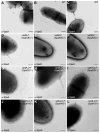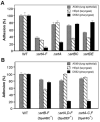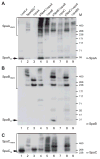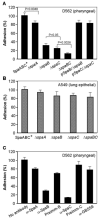Corynebacterium diphtheriae employs specific minor pilins to target human pharyngeal epithelial cells
- PMID: 17376076
- PMCID: PMC2844904
- DOI: 10.1111/j.1365-2958.2007.05630.x
Corynebacterium diphtheriae employs specific minor pilins to target human pharyngeal epithelial cells
Abstract
Adherence to host tissues mediated by pili is pivotal in the establishment of infection by many bacterial pathogens. Corynebacterium diphtheriae assembles on its surface three distinct pilus structures. The function and the mechanism of how various pili mediate adherence, however, have remained poorly understood. Here we show that the SpaA-type pilus is sufficient for the specific adherence of corynebacteria to human pharyngeal epithelial cells. The deletion of the spaA gene, which encodes the major pilin forming the pilus shaft, abolishes pilus assembly but not adherence to pharyngeal cells. In contrast, adherence is greatly diminished when either minor pilin SpaB or SpaC is absent. Antibodies directed against either SpaB or SpaC block bacterial adherence. Consistent with a direct role of the minor pilins, latex beads coated with SpaB or SpaC protein bind specifically to pharyngeal cells. Therefore, tissue tropism of corynebacteria for pharyngeal cells is governed by specific minor pilins. Importantly, immunoelectron microscopy and immunofluorescence studies reveal clusters of minor pilins that are anchored to cell surface in the absence of a pilus shaft. Thus, the minor pilins may also be cell wall anchored in addition to their incorporation into pilus structures that could facilitate tight binding to host cells during bacterial infection.
Figures









Similar articles
-
Cell surface display of minor pilin adhesins in the form of a simple heterodimeric assembly in Corynebacterium diphtheriae.Mol Microbiol. 2011 Mar;79(5):1236-47. doi: 10.1111/j.1365-2958.2010.07515.x. Epub 2011 Jan 5. Mol Microbiol. 2011. PMID: 21205008 Free PMC article.
-
Housekeeping sortase facilitates the cell wall anchoring of pilus polymers in Corynebacterium diphtheriae.Mol Microbiol. 2007 Nov;66(4):961-74. doi: 10.1111/j.1365-2958.2007.05968.x. Epub 2007 Oct 4. Mol Microbiol. 2007. PMID: 17919283 Free PMC article.
-
Adhesion by pathogenic corynebacteria.Adv Exp Med Biol. 2011;715:91-103. doi: 10.1007/978-94-007-0940-9_6. Adv Exp Med Biol. 2011. PMID: 21557059 Review.
-
Assembly of pili on the surface of Corynebacterium diphtheriae.Mol Microbiol. 2003 Nov;50(4):1429-38. doi: 10.1046/j.1365-2958.2003.03782.x. Mol Microbiol. 2003. PMID: 14622427
-
Pilus biogenesis of Gram-positive bacteria: Roles of sortases and implications for assembly.Protein Sci. 2017 Aug;26(8):1458-1473. doi: 10.1002/pro.3191. Epub 2017 May 15. Protein Sci. 2017. PMID: 28493331 Free PMC article. Review.
Cited by
-
A tale of two pili: assembly and function of pili in bacteria.Trends Microbiol. 2010 May;18(5):224-32. doi: 10.1016/j.tim.2010.03.002. Epub 2010 Apr 8. Trends Microbiol. 2010. PMID: 20378353 Free PMC article. Review.
-
Genomic analysis of endemic clones of toxigenic and non-toxigenic Corynebacterium diphtheriae in Belarus during and after the major epidemic in 1990s.BMC Genomics. 2017 Nov 13;18(1):873. doi: 10.1186/s12864-017-4276-3. BMC Genomics. 2017. PMID: 29132312 Free PMC article.
-
Genomic analysis of a novel nontoxigenic Corynebacterium diphtheriae strain isolated from a cancer patient.New Microbes New Infect. 2019 Apr 9;30:100544. doi: 10.1016/j.nmni.2019.100544. eCollection 2019 Jul. New Microbes New Infect. 2019. PMID: 31061711 Free PMC article.
-
Genomics of Corynebacterium striatum, an emerging multidrug-resistant pathogen of immunocompromised patients.Clin Microbiol Infect. 2018 Sep;24(9):1016.e7-1016.e13. doi: 10.1016/j.cmi.2017.12.024. Epub 2018 Jan 9. Clin Microbiol Infect. 2018. PMID: 29326010 Free PMC article.
-
Phylogenomic characterisation of a novel corynebacterial species pathogenic to animals.Antonie Van Leeuwenhoek. 2020 Aug;113(8):1225-1239. doi: 10.1007/s10482-020-01430-5. Epub 2020 Jun 4. Antonie Van Leeuwenhoek. 2020. PMID: 32500295 Free PMC article.
References
-
- Ankri S, Reyes O, Leblon G. Electrotransformation of highly DNA-restrictive corynebacteria with synthetic DNA. Plasmid. 1996;35:62–66. - PubMed
-
- Braun L, Ohayon H, Cossart P. The InIB protein of Listeria monocytogenes is sufficient to promote entry into mammalian cells. Mol Microbiol. 1998;27:1077–1087. - PubMed
Publication types
MeSH terms
Substances
Grants and funding
LinkOut - more resources
Full Text Sources

